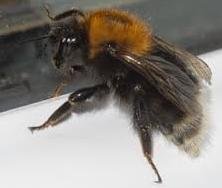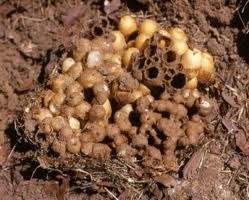We have redesigned our website
We are pleased that you chose to take a look at our training, but you have clicked on an old link. We have recently redesigned and updated our website.
You will find the same information - hopefully easier to read - on our new website: https://romseybeekeepers.com/?page_id=37 (or search for "Romsey Beekeeping Association" and follow the link on the home page.)
You will find the same information - hopefully easier to read - on our new website: https://romseybeekeepers.com/?page_id=37 (or search for "Romsey Beekeeping Association" and follow the link on the home page.)
About BUMBLE BEES - Nesting in nooks and crannies
The bumble bee leads a quiet life for one season and is best left undisturbed if possibleClick on a picture in the line below to read about that topic
Encourage the BUMBLE BEE
There are many species of BUMBLE BEE in the UK, with 8 species being the most common. When you think of bees, it is the image of a bumble bees that comes to mind - round, furry, and rolling along from blossom to blossom gathering nectar and pollen.
Given encouragement and plenty good forage, the bumble bee will repay your kindness by pollinating your flowers, fruit and vegetables and giving you an excellent set on your blossom. Click on our 'PLANTS' link above for suggestions.
Given encouragement and plenty good forage, the bumble bee will repay your kindness by pollinating your flowers, fruit and vegetables and giving you an excellent set on your blossom. Click on our 'PLANTS' link above for suggestions.
The Tree Bumblebee - Bombus hypnorum
These have a black head, brown-ginger thorax, black abdomen and a white tail. It is a fairly recent arrival in the UK but has spread quickly.As its common name suggests, the queen prefers to nest above ground and they are often found in bird boxes.
She raises her brood and later in the season virgin queens will emerge. Large numbers of drones congregate outside a tree bumblebee nest waiting for the young queens coming out for mating flights snd this can easily be confused with a swarm of honey bees.
She raises her brood and later in the season virgin queens will emerge. Large numbers of drones congregate outside a tree bumblebee nest waiting for the young queens coming out for mating flights snd this can easily be confused with a swarm of honey bees.
Bumble bees never swarm
Because they live in small nests, they do not need to move home so you can encourage a nest or two in the garden without fear of this happening.
Bumble bees are not aggressive and they will not attack a human unless their life is under threat.
Drones (smaller male bees) hatch in mid summer and the sudden increase in bee numbers can frighten people who are nervous about insects;but drone bees have no sting.
Bumble bees are not aggressive and they will not attack a human unless their life is under threat.
Drones (smaller male bees) hatch in mid summer and the sudden increase in bee numbers can frighten people who are nervous about insects;but drone bees have no sting.
Enemies of the Bumble Bee
A bumble bee's biggest enemy by far is a man armed with a pesticide spray. Like every other form of wildlife they are under serious threat from the chemicals we pour on the land. Two species have recently become extinct in the UK.
If you find a nest, try not to disturb it. If it is in an awkward place try to put up with it for a few weeks. It will die out with the first frosts and can then be safely removed.
If you want to help the bees let the lawn grow a little longer around the nest area.
If you find a nest, try not to disturb it. If it is in an awkward place try to put up with it for a few weeks. It will die out with the first frosts and can then be safely removed.
If you want to help the bees let the lawn grow a little longer around the nest area.
Bumblebee Conservation Trust
You can find out all you need to know about bumble bees by visiting the Bumblebee Conservation Trust website
There you can upload images of bumblebees that you have seen and check your identification.You can also find information about their habitat, plant preferences, and the Trust's projects
There you can upload images of bumblebees that you have seen and check your identification.You can also find information about their habitat, plant preferences, and the Trust's projects








